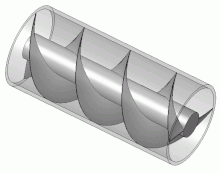Twist (wave)
Twist is the surface property of a rotating shaft that is decisive for the tightness of the shaft seal . Twist is a form of roughness .
A very pronounced twist structure is comparable to a thread . Since the shaft runs in a lubricant , a shaft with a swirl acts like a worm pump that transports the lubricant through the seal. As a result, depending on the direction of rotation, the seal either leaks or runs dry. Ideally, components are therefore twist-free, at least in the area of the shaft seal .
Terms
A distinction is made between macro- and micro-twist: Macrodrall has a recognizable directional structure that dominates the surface roughness, while with microdrall this lubricant-promoting structure disappears in the surface roughness. The terms presented below are therefore only applicable to macro twist. Among other things, they are used in ISO 25178-3 to describe the twist of a shaft:
- Swirl period
- The period length of the twist in the axial direction.
- Mobility
- The number of periods that the twist shifts along the axis when the shaft rotates, or the number of periods that are recorded with a stationary sensor when the shaft rotates. A normal thread has a pitch of 1, typical pitches of shafts are a few 10 to 50.
- Zero twist
- A twist without a slope. Not to be confused with freedom from twist . The shaft has a distinctive structure, which, however, merges into itself with one rotation. With ideal guidance in the shaft seal, a shaft with zero twist would be tight. Unfortunately, this is not the case because of the inevitable tolerances and since a perfect zero twist rarely occurs in reality. Attempts are therefore made to avoid the zero twist as well as the twist with a higher pitch.
- Freedom from twist
- The shaft does not have any periodic structures worth mentioning that could transport lubricant when it rotates. That is the ideal state you want. However, freedom from twist is not a sufficient condition for tightness.
- Helix angle
- The angle that the twist forms to the axis of rotation of the shaft. With zero twist, the twist angle is 0 °.
- Twist depth
- The depth of the periodic structures that cause the twist.
- Funding cross-section
- The delivery cross-section is the theoretical volume of lubricant that the shaft would deliver during one revolution if it had been fitted into a perfect sealing ring.
Twist test and twist measurement
The Shaft Twist Test (abbr. STT) determines the presence or absence of twist structures without making a quantitative statement. In the simplest case, it is done using the thread method. A lightly oiled thread is looped around the shaft so that it has a wrap angle of around 220 °. The loop is weighted with a defined weight. The shaft is then accelerated to a specified speed. If the thread loop moves away to the right or left, the wave is not free of twist. The main disadvantage of the method, however, is that the method demonstrably fails in the case of very small or very large twist structures.
Twist testers based on the scattered light method offer an alternative to the thread method. The tester immediately recognizes the presence of twist structures on the surface of the manufactured component.
The quantitative twist measurement is carried out, among other things, with tactile or optical profilometers , the profile data of which are assessed using complex mathematical processes.
literature
- ↑ ISO / DIS 25178-3 : 2008: Geometrical Product Specifications (GPS) - Surface texture: Areal, Part 3: Specification operators
- Christian Bätzel: Twist measurement with method in workshop reports , Carl Hanser Verlag Munich, 5/2008.
- Jörg Seewig, H.-J. Jordan, Tobias Hercke, Raimund Volk: Optical High Speed Twist Characterization , XII International Colloquium on Surfaces Chemnitz, January 28th and 29th, 2008
- Mercedes-Benz works standard MBN 31007-7: Geometrical product specifications (GPS) - surface quality - measuring and evaluation methods for the evaluation of swirl-reduced dynamic sealing surfaces

